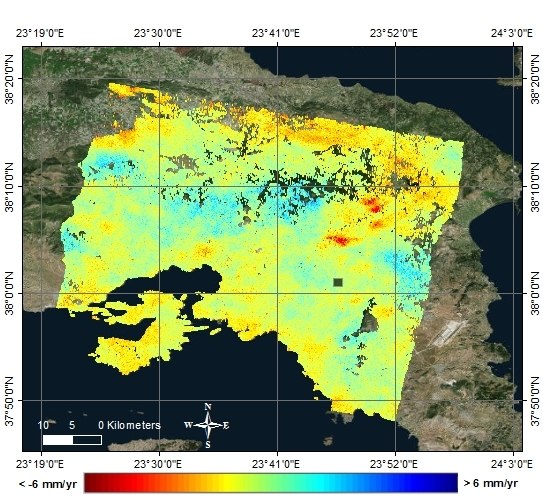Multi-Stack Persistent Scatterer Interferometry Analysis in Wider Athens, Greece
Abstract
:1. Introduction
2. Geodynamic Setting
3. Datasets and Processing Strategy
4. Time Series Analysis Results
4.1. The 1992–1999 ERS Period
4.2. The 2002–2010 Envisat Period
5. Multi-Track Joint Analysis
5.1. Methodology
5.2. Velocity Decomposition
6. Discussion
6.1. Aquifers Overexploitation
6.2. Aseismic Creep
7. Conclusions
Supplementary Materials
Acknowledgments
Author Contributions
Conflicts of Interest
References
- Andrianakis, V.; Voulgaris, N. New Seismic Hazard Map for Greece; Technical Report; Earthquake Planning and Protection Organization: Neo Psichiko, Greece, 2003. (In Greek) [Google Scholar]
- Tselentis, G.A.; Zahradnik, J. The Athens Earthquake of 7 September 1999. Bull. Seismol. Soc. Am. 2000, 90, 1143–1160. [Google Scholar] [CrossRef]
- Zebker, H.A.; Goldstein, R.M. Topographic mapping from interferometric synthetic aperture radar observations. J. Geophys. Res. Solid Earth 1986, 91, 4993–4999. [Google Scholar] [CrossRef]
- Gabriel, A.K.; Goldstein, R.M.; Zebker, H.A. Mapping small elevation changes over large areas: Differential radar interferometry. J. Geophys. Res. Solid Earth 1989, 94, 9183–9191. [Google Scholar] [CrossRef]
- Massonnet, D.; Feigl, K.L. Radar interferometry and its application to changes in the Earth’s surface. Rev. Geophys. 1998, 36, 441–500. [Google Scholar] [CrossRef]
- Ferretti, A.; Prati, C.; Rocca, F. Permanent scatterers in SAR interferometry. IEEE Trans. Geosci. Remote Sens. 2001, 39, 8–20. [Google Scholar] [CrossRef]
- Tofani, V.; Raspini, F.; Catani, F.; Casagli, N. Persistent Scatterer Interferometry (PSI) Technique for Landslide Characterization and Monitoring. Remote Sens. 2013, 5, 1045–1065. [Google Scholar] [CrossRef]
- Ferretti, A.; Fumagalli, A.; Novali, F.; Prati, C.; Rocca, F.; Rucci, A. A New Algorithm for Processing Interferometric Data-Stacks: SqueeSAR. IEEE Trans. Geosci. Remote Sens. 2011, 49, 3460–3470. [Google Scholar] [CrossRef]
- Hooper, A.; Segall, P.; Zebker, H. Persistent scatterer interferometric synthetic aperture radar for crustal deformation analysis, with application to Volcán Alcedo, Galápagos. J. Geophys. Res. 2007, 112, B07407. [Google Scholar] [CrossRef]
- Werner, C.; Wegmuller, U.; Strozzi, T.; Wiesmann, A. Interferometric point target analysis for deformation mapping. In Proceedings of the 2003 IEEE International Geoscience and Remote Sensing Symposium (IGARSS ’03), Toulouse, France, 21–25 July 2003; Volume 7, pp. 4362–4364.
- Berardino, P.; Fornaro, G.; Lanari, R.; Sansosti, E. A new algorithm for surface deformation monitoring based on small baseline differential SAR interferograms. IEEE Trans. Geosci. Remote Sens. 2002, 40, 2375–2383. [Google Scholar] [CrossRef]
- Terrafirma. Stage 1 Results: Athens Greece; Technical Report; Terrafirma EC Project; Terrafirma: Athens, Greece, 2004. [Google Scholar]
- Papoutsis, I.; Kontoes, C.; Massinas, B.; Paradissis, D.; Frangos, P. Assessing the pre-seismic and post-seismic displacement in the Athens metropolitan area by SAR Interferometric Point Target Analysis, using ERS and Envisat datasets. In Proceedings of the Workshop Fringe 2009, Frascati, Italy, 30 November–4 December 2009.
- Parcharidis, I.; Lagios, E.; Sakkas, V.; Raucoules, D.; Feurer, D.; Mouelic, S.L.; King, C.; Carnec, C.; Novali, F.; Ferretti, A.; et al. Subsidence monitoring within the Athens Basin (Greece) using space radar interferometric techniques. Earth Planets Space 2006, 58, 505–513. [Google Scholar] [CrossRef]
- Foumelis, M. Human induced groundwater level declination and physical rebound in northern Athens Basin (Greece) observed by multi-reference DInSAR techniques. In Proceedings of the 2012 IEEE International Geoscience and Remote Sensing Symposium (IGARSS), Munich, Germany, 22–27 July 2012; pp. 820–823.
- Crosetto, M.; Monserrat, O.; Cuevas-González, M.; Devanthéry, N.; Crippa, B. Persistent Scatterer Interferometry: A review. ISPRS J. Photogram. Remote Sens. 2016, 115, 78–89. [Google Scholar] [CrossRef]
- Lekkas, E. The Athens earthquake (7 September 1999): Intensity distribution and controlling factors. Eng. Geol. 2001, 59, 297–311. [Google Scholar] [CrossRef]
- Papanikolaou, D.; Papanikolaou, I. Geological, geomorphological and tectonic structure of NE Attica and seismic hazard implications for the northern edge of the Athens Plain. Bull. Geol. Soc. Greece 2007, 40, 425–438. [Google Scholar]
- Xypolias, P.; Kokkalas, S.; Skourlis, K. Upward extrusion and subsequent transpression as a possible mechanism for the exhumation of HP/LT rocks in Evia Island (Aegean Sea, Greece). J. Geodyn. 2003, 35, 303–332. [Google Scholar] [CrossRef]
- Galanopoulos, D. Plate tectonics in the area of Greece as reflected in the deep focus seismicity. Bull. Geol. Soc. Greece 1972, IX/2, 266–285. [Google Scholar]
- Papazachos, V.; Papazachos, B.; Papazachou, C.; Papazachou, K. The Earthquakes of Greece; Editions Ziti: Thessaloniki, Greece, 1997. [Google Scholar]
- Kontoes, C.; Elias, P.; Sykioti, O.; Briole, P.; Remy, D.; Sachpazi, M.; Veis, G.; Kotsis, I. Displacement field and fault model for the September 7, 1999 Athens Earthquake inferred from ERS2 Satellite radar interferometry. Geophys. Res. Lett. 2000, 27, 3989–3992. [Google Scholar] [CrossRef]
- Foumelis, M.; Parcharidis, I.; Lagios, E.; Voulgaris, N. Evolution of post-seismic ground deformation of the Athens 1999 earthquake observed by SAR interferometry. J. Appl. Geophys. 2009, 69, 16–23. [Google Scholar] [CrossRef]
- Kotsis, I.; Kontoes, C.; Paradissis, D.; Karamitsos, S.; Elias, P.; Papoutsis, I. A Methodology to Validate the InSAR Derived Displacement Field of the September 7th, 1999 Athens Earthquake Using Terrestrial Surveying. Improvement of the Assessed Deformation Field by Interferometric Stacking. Sensors 2008, 8, 4119–4134. [Google Scholar] [CrossRef] [PubMed]
- Roumelioti, Z.; Dreger, D.; Kiratzi, A.; Theodoulidis, N. Slip Distribution of the 7 September 1999 Athens Earthquake Inferred from an Empirical Green’s Function Study. Bull. Seismol. Soc. Am. 2003, 93, 775–782. [Google Scholar] [CrossRef]
- Baumont, D.; Courboulex, F.; Scotti, O.; Melis, N.S.; Stavrakakis, G. Slip distribution of the Mw 5.9, 1999 Athens earthquake inverted from regional seismological data. Geophys. Res. Lett. 2002, 29, 15-1–15-4. [Google Scholar] [CrossRef]
- Papadimitriou, P.; Voulgaris, N.; Kassaras, I.; Kaviris, G.; Delibasis, N.; Makropoulos, K. The Mw = 6.0, 7 September 1999 Athens earthquake. Nat. Hazards 2002, 27, 15–33. [Google Scholar] [CrossRef]
- Pavlides, S.; Papadopoulos, G.; Ganas, A. The Fault that Caused the Athens September 1999 Ms = 5.9 Earthquake: Field Observations. Nat. Hazards 2002, 27, 61–84. [Google Scholar] [CrossRef]
- Goldsworthy, M.; Jackson, J.; Haines, J. The continuity of active fault systems in Greece. Geophys. J. Int. 2002, 148, 596–618. [Google Scholar] [CrossRef]
- Bouckovalas, G.; Kouretzis, G. Stiff soil amplification effects in the 7 September 1999 Athens (Greece) earthquake. Soil Dyn. Earthq. Eng. 2001, 21, 671–687. [Google Scholar] [CrossRef]
- Eftaxias, K.; Kapiris, P.; Polygiannakis, J.; Bogris, N.; Kopanas, J.; Antonopoulos, G.; Peratzakis, A.; Hadjicontis, V. Signature of pending earthquake from electromagnetic anomalies. Geophys. Res. Lett. 2001, 28, 3321–3324. [Google Scholar] [CrossRef]
- Kampes, B. Radar Interferometry: Persistent Scatterer Technique; Remote Sensing and Digital Image Processing Series; Springer: London, UK, 2006. [Google Scholar]
- Sousa, J.; Hooper, A.; Hanssen, R.; Bastos, L. Comparative Study of Two Different PS-INSAR Approaches: DEPSI vs. STAMPS. In Proceedings of the Workshop Fringe 2009, Frascati, Italy, 30 November–4 December 2009; Volume 677.
- Kampes, B.; Usai, S. Delft Object oriented radar interferometric software. In Proceedings of the 2nd International Symposium on Operationalization of Remote Sensing, Enschede, The Netherlands, 16–20 August 1999.
- Scharroo, R.; Visser, P. Precise orbit determination and gravity field improvement for the ERS satellites. J. Geophys. Res. Oceans 1998, 103, 8113–8127. [Google Scholar] [CrossRef]
- Farr, T.G.; Kobrick, M. Shuttle radar topography mission produces a wealth of data. Eos Trans. AGU 2000, 81, 583–585. [Google Scholar] [CrossRef]
- Hooper, A. A multi-temporal InSAR method incorporating both persistent scatterer and small baseline approaches. Geophys. Res. Lett. 2008, 35, L16302. [Google Scholar] [CrossRef]
- Ketelaar, G.; van Leijen, F.; Marinkovic, P.; Hanssen, R. Multi-track PS-InSAR datum connection. In Proceedings of the 2007 IEEE International Geoscience and Remote Sensing Symposium (IGARSS 2007), Barcelona, Spain, 23–28 July 2007; pp. 2481–2484.
- Wright, T.J.; Parsons, B.E.; Lu, Z. Toward mapping surface deformation in three dimensions using InSAR. Geophys. Res. Lett. 2004, 31. [Google Scholar] [CrossRef]
- Bechor, N.B.D.; Zebker, H.A. Measuring two-dimensional movements using a single InSAR pair. Geophys. Res. Lett. 2006, 33. [Google Scholar] [CrossRef]
- Fialko, Y.; Simons, M.; Agnew, D. The complete (3-D) surface displacement field in the epicentral area of the 1999 MW7.1 Hector Mine Earthquake, California, from space geodetic observations. Geophys. Res. Lett. 2001, 28, 3063–3066. [Google Scholar] [CrossRef]
- Samieie-Esfahany, S.; Hanssen, R.; van Thienen-Visser, K.; Muntendam-Bos, A. On the effect of horizontal deformation on InSAR subsidence estimates. In Proceedings of the Workshop Fringe 2009, Frascati, Italy, 30 November–4 December 2009.
- Hu, J.; Li, Z.; Ding, X.; Zhu, J.; Zhang, L.; Sun, Q. Resolving three-dimensional surface displacements from InSAR measurements: A review. Earth-Sci. Rev. 2014, 133, 1–17. [Google Scholar] [CrossRef]
- Kallis, G.; Coccossis, H. Managing Water for Athens: From the Hydraulic to the Rational Growth Paradigm. Eur. Plan. Stud. 2003, 11, 245–261. [Google Scholar] [CrossRef]
- Svigkas, N.; Papoutsis, I.; Loupasakis, C.; Tsangaratos, P.; Kiratzi, A.; Kontoes, C. Land subsidence rebound detected via multi-temporal InSAR and ground truth data in Kalochori and Sindos regions, Northern Greece. Eng. Geol. 2016, 209, 175–186. [Google Scholar]
- Hetland, E.A.; Simons, M.; Dunham, E.M. Post-seismic and interseismic fault creep I: Model description. Geophys. J. Int. 2010, 181, 81–98. [Google Scholar] [CrossRef]
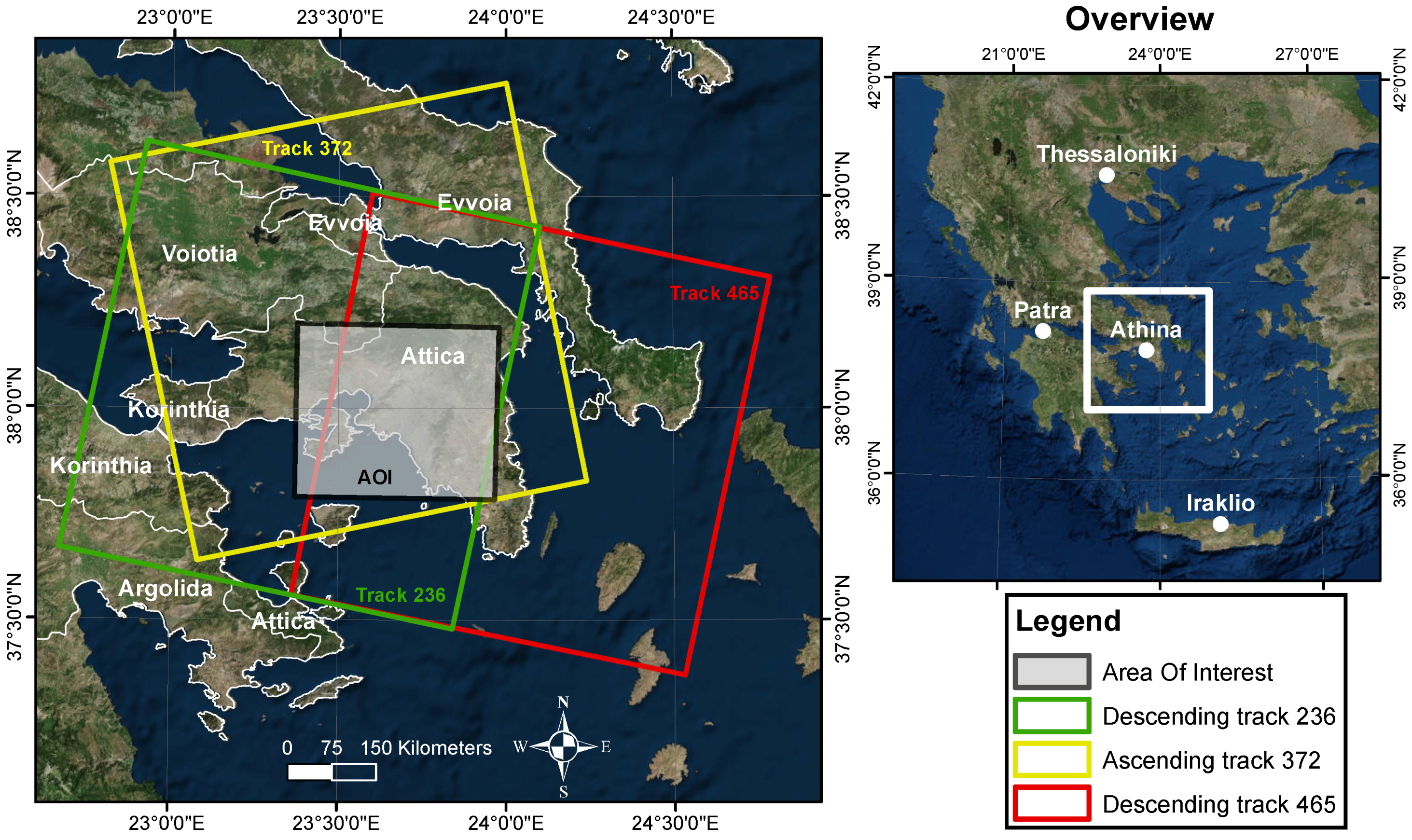

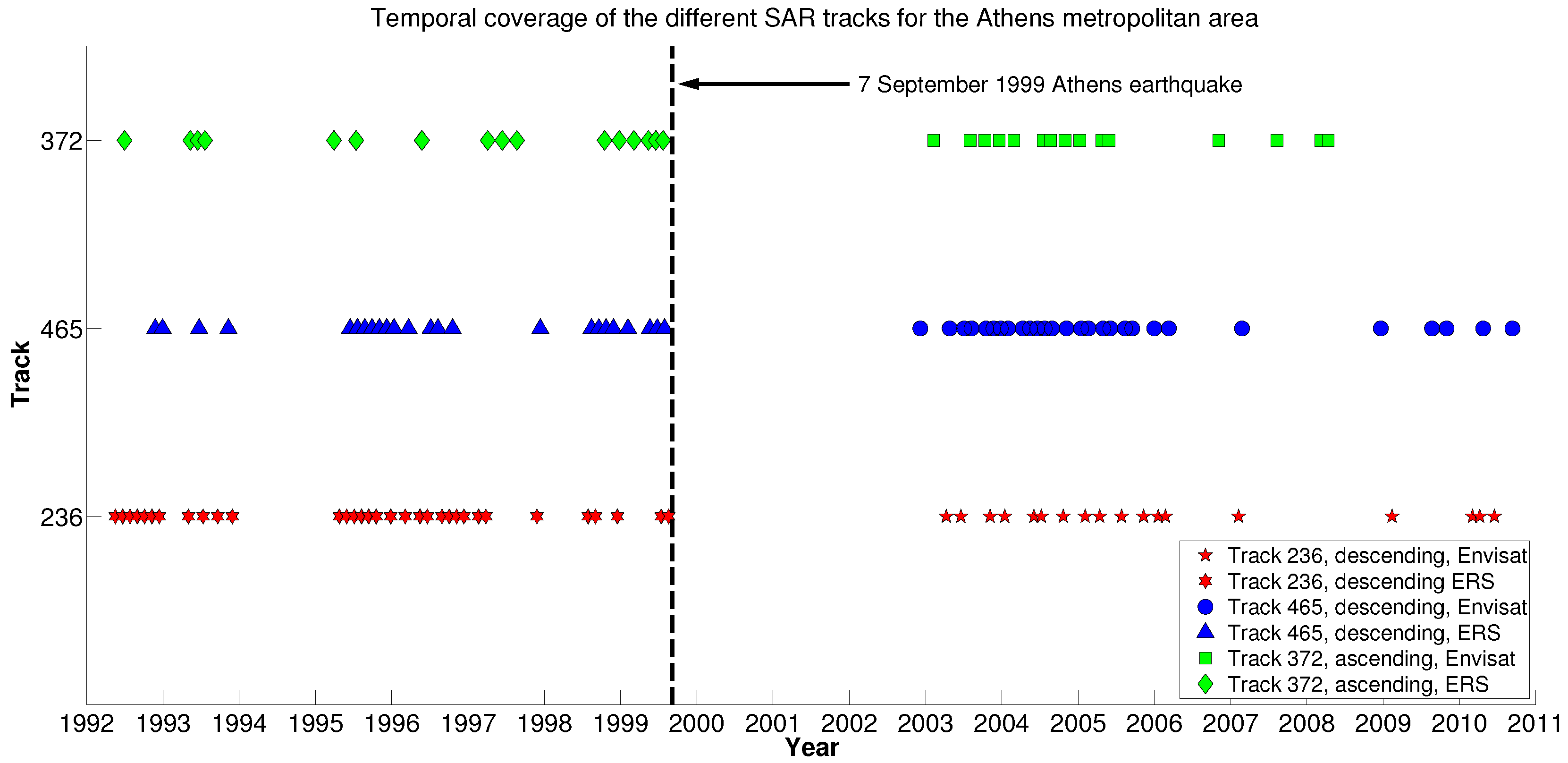
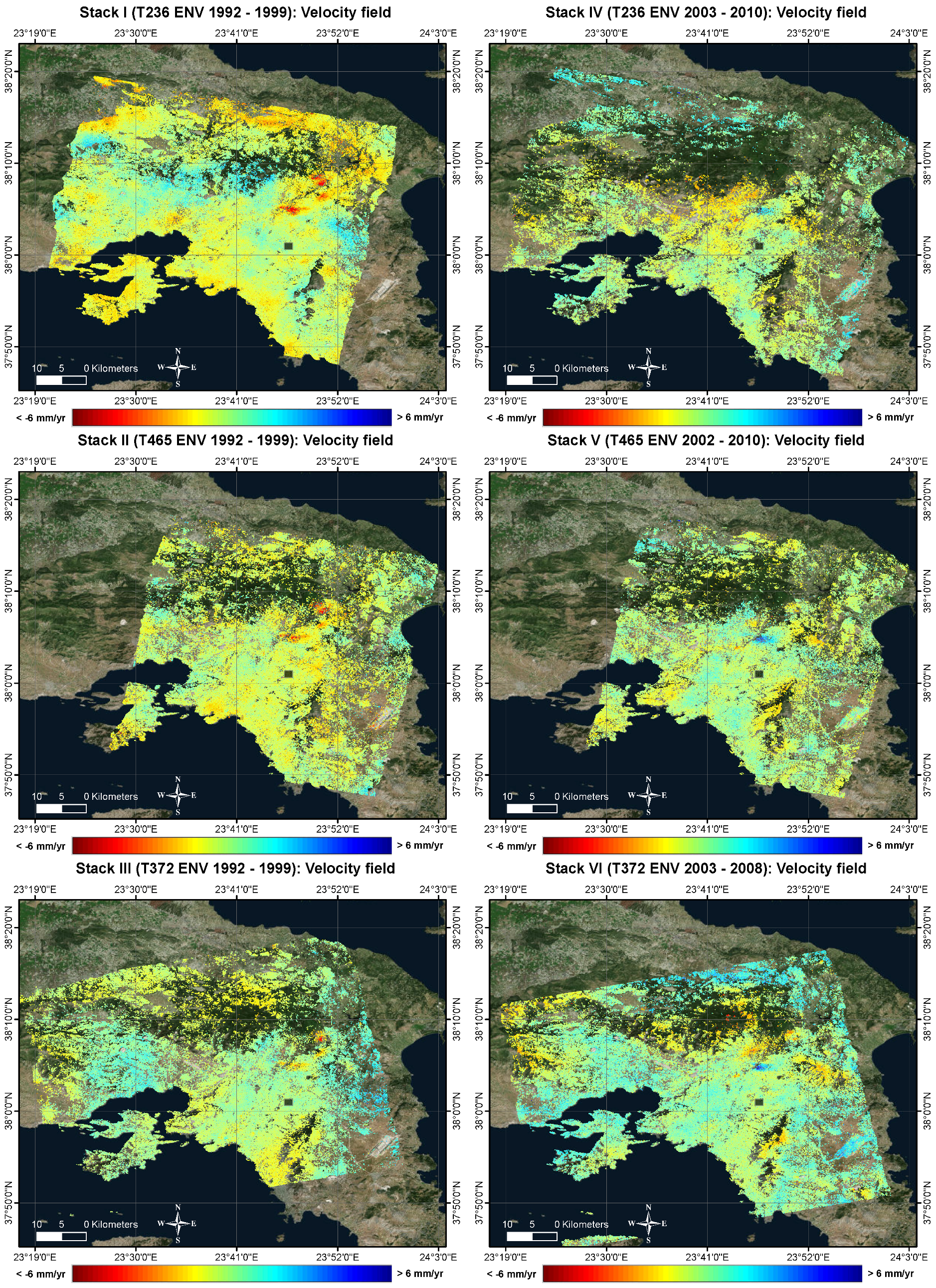

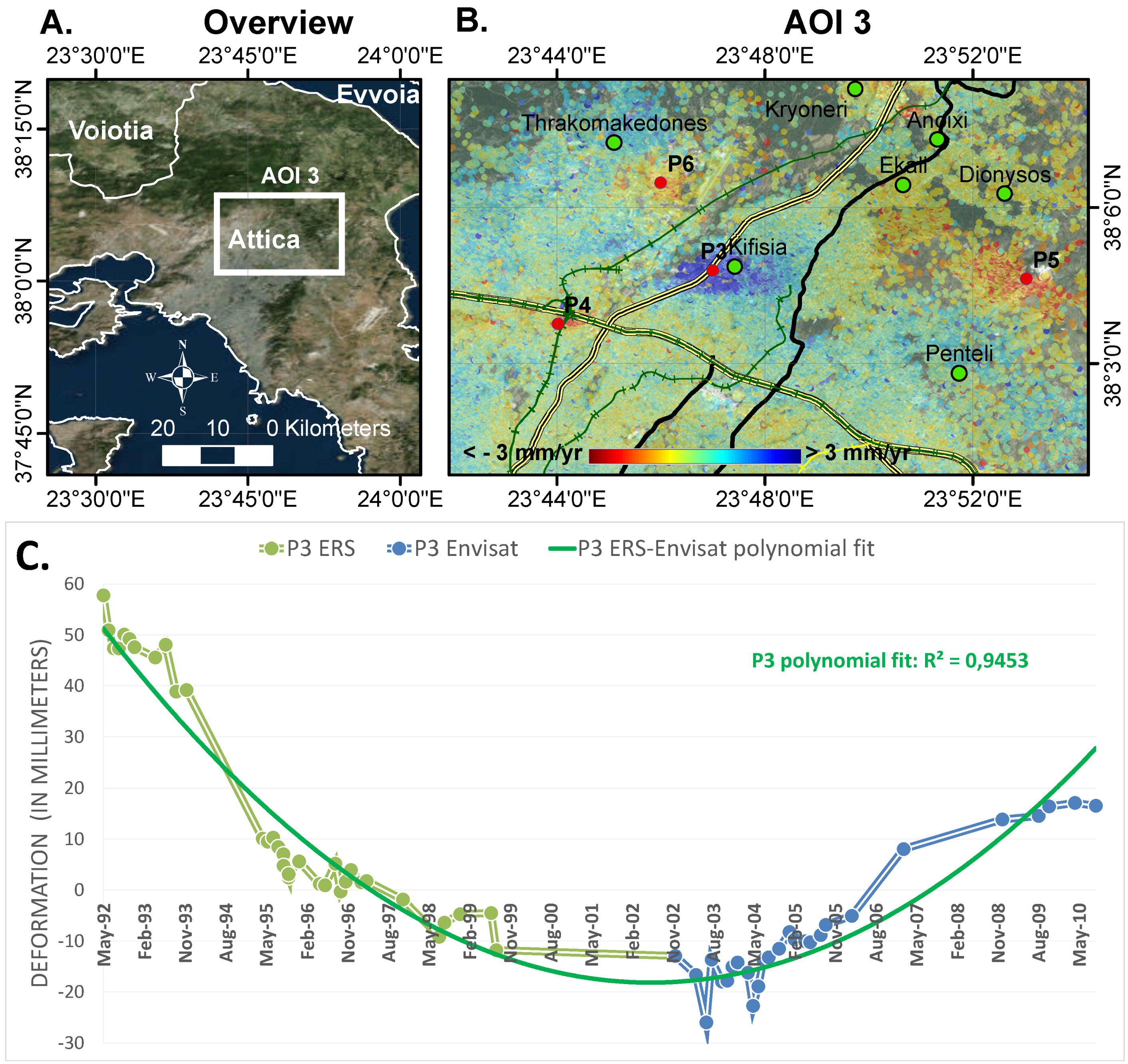
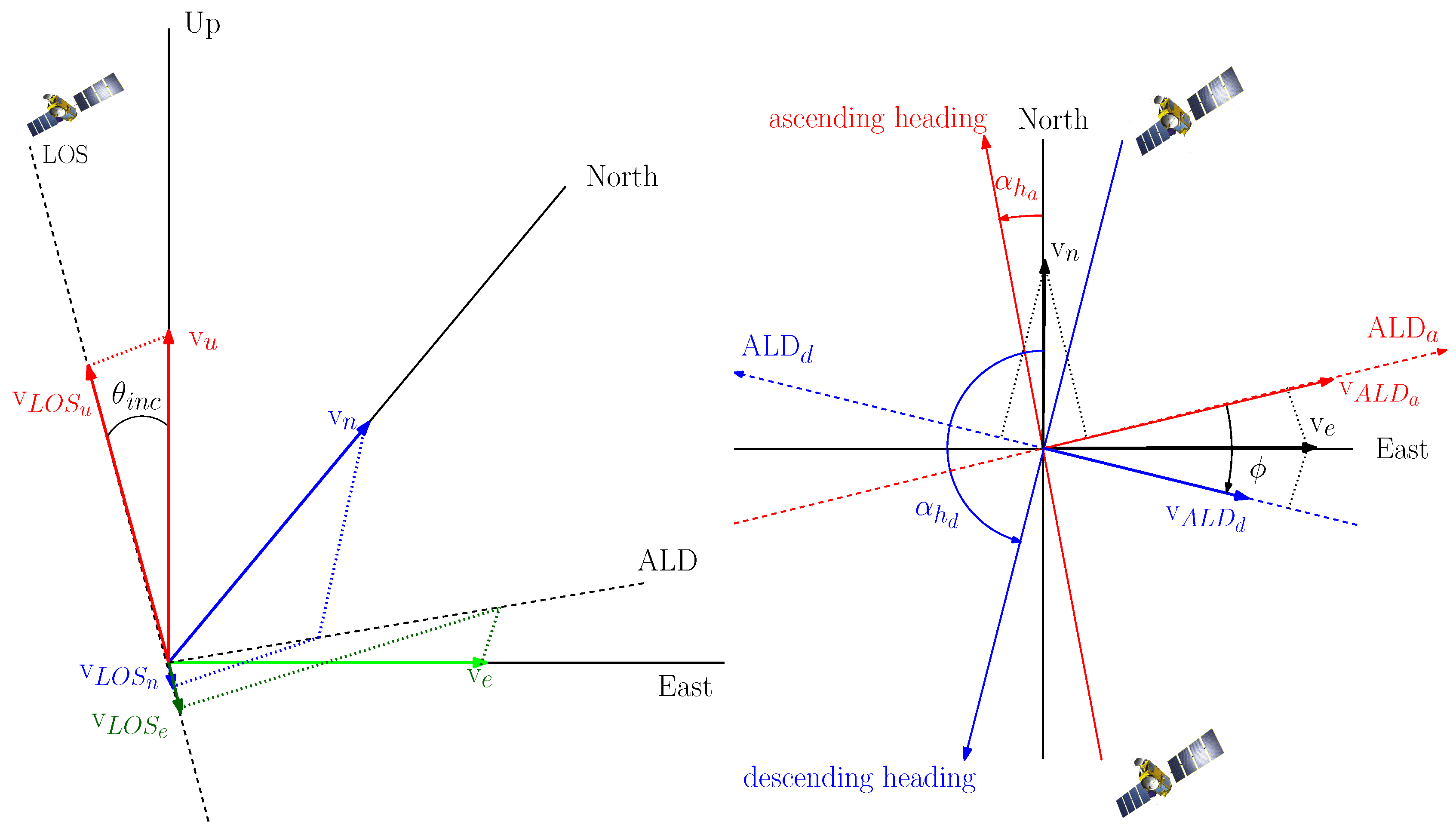
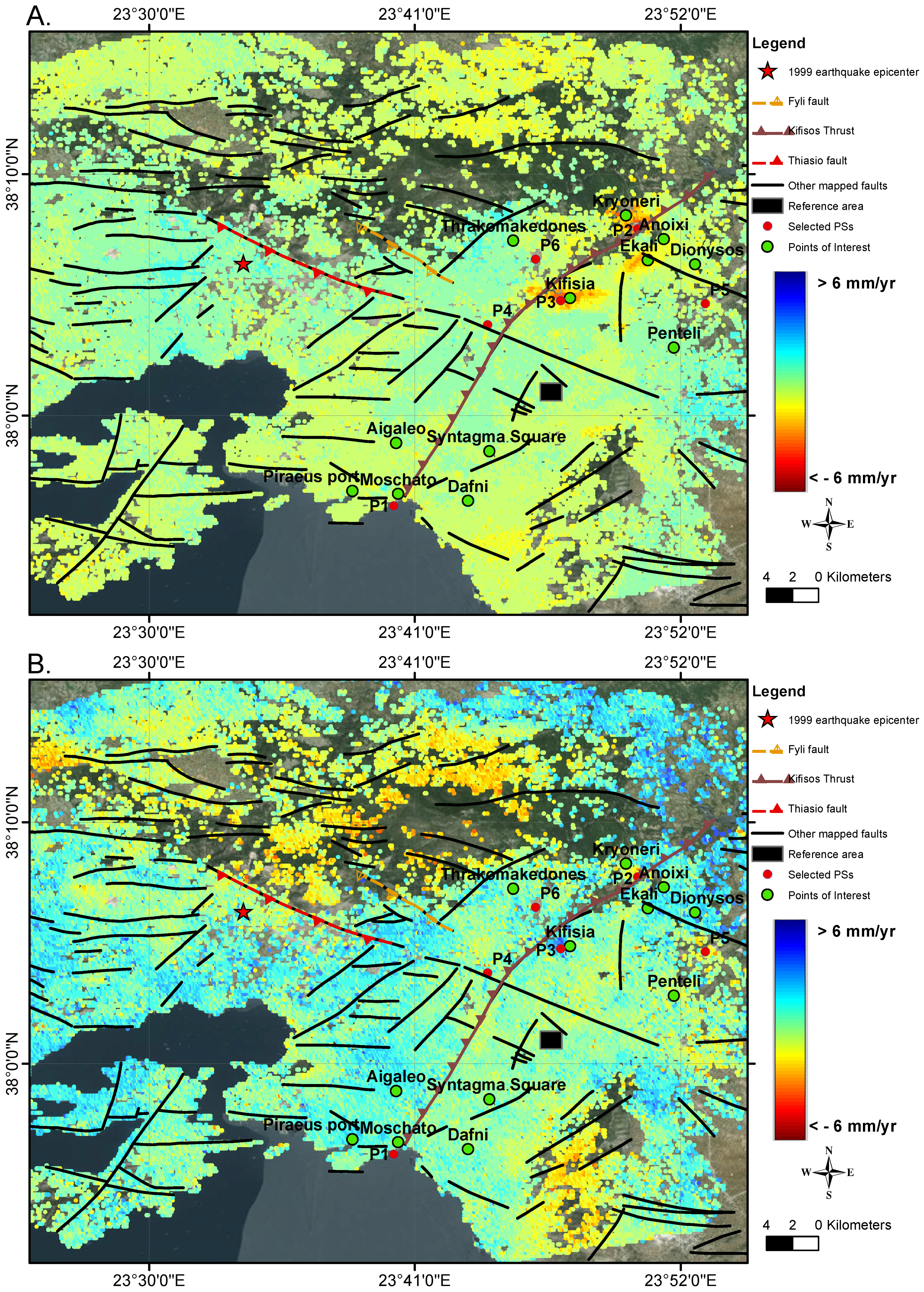

| Stack | Interval | Track | Satellite | Mode | Scenes |
|---|---|---|---|---|---|
| I | 1992–1999 | 236 | ERS | Descending | 37 |
| II | 1992–1999 | 465 | ERS | Descending | 30 |
| III | 1992–1999 | 372 | ERS | Ascending | 18 |
| IV | 2003–2010 | 236 | Envisat | Descending | 18 |
| V | 2002–2010 | 465 | Envisat | Descending | 28 |
| VI | 2003–2008 | 372 | Envisat | Ascending | 15 |
© 2017 by the authors. Licensee MDPI, Basel, Switzerland. This article is an open access article distributed under the terms and conditions of the Creative Commons Attribution (CC BY) license ( http://creativecommons.org/licenses/by/4.0/).
Share and Cite
Papoutsis, I.; Kontoes, C.; Paradissis, D. Multi-Stack Persistent Scatterer Interferometry Analysis in Wider Athens, Greece. Remote Sens. 2017, 9, 276. https://doi.org/10.3390/rs9030276
Papoutsis I, Kontoes C, Paradissis D. Multi-Stack Persistent Scatterer Interferometry Analysis in Wider Athens, Greece. Remote Sensing. 2017; 9(3):276. https://doi.org/10.3390/rs9030276
Chicago/Turabian StylePapoutsis, Ioannis, Charalampos Kontoes, and Demitrios Paradissis. 2017. "Multi-Stack Persistent Scatterer Interferometry Analysis in Wider Athens, Greece" Remote Sensing 9, no. 3: 276. https://doi.org/10.3390/rs9030276





